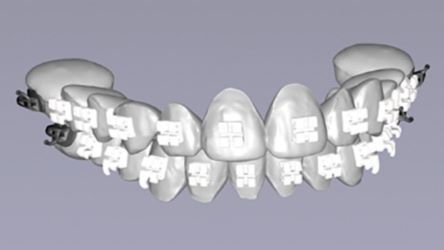The desire for a confident smile leads individuals of all ages to explore orthodontic treatment. A common question is, “How long do braces take?” In this paragraph, I’m using the word “braces” to stand in for all appliance types, including precision braces on teeth such as LightForce 3-D brackets, as well as Invisalign aligners, and the invisible Brava device.
Orthodontic treatment is not a one-size-fits-all concept; its duration is influenced by a multitude of factors. The path to a confident smile begins with a comprehensive examination to assess each patient’s unique circumstances, including the severity of dental misalignment and/or skeletal imbalances, as well as the patient’s age, familial facial forms, current oral health, and desired outcome.
Treatment length will vary by the complexity of the movements required to achieve the desired outcome and can range from a few to eighteen months. Longer treatments are also possible depending upon the factors discussed below.
Orthodontic Treatment Duration: Factors Influencing Duration
Let’s delve deeper into the elements that contribute to the length of time braces or other appliances such as Invisalign aligners or the Brava invisible lingual device must stay on the teeth:
Age and Growth
Age plays a pivotal role in the duration of braces on teeth. Younger patients often experience faster progress due to their growing jaws. This dynamic growth phase allows for more efficient adjustments to alignment, leading to a shorter treatment period. Adult patients also experience growth, with changes to the facial bone structure continuing throughout life. Adult growth patterns, however, have a greater influence upon appropriate treatment goals than treatment duration.
Braces on Children: Building a Foundation
Parents understand the importance of providing their children with opportunities in life and the relationship between those opportunities and a healthy and attractive smile. To that end, the American Orthodontic Association recommends that all children be screened by an orthodontist at age seven. The orthodontist will utilize a specialized examination and, if acceptable, low-dose orthodontic x-ray, to assess developmental issues that are not apparent to a general dentist. This step sets the stage for a lifetime of optimal dental health and can reduce and properly time future intervention. Limited treatment on children, commonly called interceptive treatment, can eliminate or simplify comprehensive treatment through growth guidance that avoids later imbalances requiring more extensive intervention.
Regarding the duration of braces, the malleability of growing bones allows for more efficient alignment. The inherent flexibility facilitates quicker response to treatment and shorter treatment periods. Whether correcting misalignment or skeletal issues, the process is enhanced by harnessing the natural growth patterns of a child’s jaw.
Braces on Adolescents: Navigating Growth Spurts
Adolescence is a crucial phase when developmental shifts play a significant role in orthodontic treatment efficacy. Harnessing growth spurts, orthodontists strategically plan treatment to align with the natural changes occurring within the body. This synchronization between orthodontic treatment and physical development contributes to efficient and effective results.
Braces on Adults: Beautiful Smiles at Any Age
The pursuit of a confident smile is not limited by age. Orthodontic treatment for adults has become increasingly common given the available appliance options, noted below, and the benefits for both aesthetics and long-term oral health.
Adult braces, whether clear or utilizing LightForce 3-D printed brackets, are a practical solution for orthodontic correction. In addition, modern advancements have led to a variety of appliance options tailored to the needs and preferences of adults, including clear aligners, such as Invisalign, that are virtually invisible, and the Brava appliance, a lingual, completely invisible application that is plastic free. As noted below, the duration of these treatments varies based upon the appliance used, patient compliance, and case complexity.

Many adults find that the investment of time and effort in orthodontic treatment is well worth the confident and stable smile achieved in the end. If you’re wondering how long braces* on adults take or whether you are a suitable candidate, consult with a specialist in orthodontics to explore the most effective approach for your situation. A beautiful smile knows no age limits! In my practice, patients range in age from 6 to adults in their 70s.
*Braces in this context includes alternative appliances such as Invisalign aligners and the Brava invisible, lingual device.
Type of Orthodontic Appliance Utilized: Braces, Invisalign, Brava
Whether you’re considering traditional braces, personalized, 3-D printed, tooth-color brackets such as LightForce, or the discreet Invisalign or Brava* appliance options, the orthodontic method you choose from those appropriate for you can influence treatment duration. Each type offers unique advantages, and your orthodontist will help you select the most suitable option based upon your specific needs. From braces for adults to Invisalign aligners for children and all options in between, treatment durations will vary across individuals and methods, with some appliances better able to perform specific tasks, making the availability of appliance options to orthodontists an advantage to the patient.
*A limited number of orthodontists now utilize the Brava appliance, the most mechanically effective treatment option, which utilizes independent, tooth-moving wires attached to the back of the teeth to allow unfettered movement from the onset of treatment, unlike braces or Invisalign.
Severity of Misalignment and/or Skeletal Imbalances
The extent and complexity of misalignment is a key determinant. Patients with more pronounced or complicated misalignment may require additional treatment time to achieve optimal results given the complexity of movements that must be safely accomplished. An experienced orthodontist can inform you of your or your child’s circumstances and the associated treatment length.
Skeletal imbalances which prevent proper tooth alignment and occlusion (bite) also influence treatment duration. An orthodontist experienced in addressing these issues will be able to assess the appropriate methods and length of time to bring about the positive outcome you seek. Surgical intervention can be a welcome option for some patients, allowing them to achieve an outcome that cannot be reached by tooth movement alone. In such cases, an orthodontist experienced with complex cases can oversee and coordinate treatment with other specialists.
Oral Health
Maintaining excellent oral hygiene is essential. Good oral health not only supports the alignment process but also contributes to shorter treatment times. By prioritizing your or your child’s oral well-being, you play an active role in expediting your path to a beautiful smile. The orthodontist will assess oral health before treatment begins and, if needed, suggest corrective treatment, such as that provided by a periodontist or pedodontist, if your or your child’s teeth require greater stability before initiating orthodontic movement. Once a healthy state is reached, treatment may begin. Continued oral health remains a top priority for both you and your orthodontist because oral health will contribute to the stability of your or your child’s orthodontic result.
Patient Compliance
How long do braces take? Diligently following your orthodontist’s recommendations can significantly impact the overall duration. By actively participating in your treatment journey, you contribute to achieving your desired results in a timely manner. In addition to the consistent wearing of removable appliances, such as aligners and rubber bands, patients can avoid lengthening treatment time by avoiding damaging activities, such as chewing ice or hard foods—think of biting down on hard bread or a popcorn kernel, that disengage or break the appliances providing the force needed to keep teeth moving in the proper direction. For every hour the tooth is not engaged by the proper force, the tooth reverts position (moves back toward its starting place) by the equivalent of six hours of active force. Reversion is much faster than positive movement! Consistent wear and proper care greatly contribute to effective and efficient treatment.
Completing Orthodontic Treatment with High-Quality Post-Treatment Care
The journey of orthodontic transformation isn’t concluded by the removal of braces or other appliances. Instead, it extends into a crucial phase, one of maintenance and retention. Whether you embarked on the journey as a child, embraced orthodontics as an adult, or fell somewhere in between, post-treatment care is an important aspect of your overall treatment. Maintaining the smile you have achieved is not difficult but requires a partnership with your orthodontist and your or your child’s participation.
Conclusion
Orthodontic treatment with braces or other appliances typically may last from a few to as many as 18 months depending upon the patient’s age, the movements that must be accomplished, the appliances that are used, the complexity of the orthodontic treatment that is necessitated by the patient’s presenting condition, and the patient’s oral health and commitment to participating in the treatment process to facilitate a successful result.
To learn more, I advise you to seek one or more examinations with experienced orthodontists in your area to explore the appropriate and most preferred treatment modalities for you or your child.
If you are considering orthodontic treatment in the Seattle metro area, including Invisalign aligners, Brava, or braces for adults or children, I would be happy to assist you. Contact my practice (Keith B. Wong, DDS, MS, Specialist in Orthodontics) to schedule a complimentary examination. Having created over 8,000 personalized treatment plans catering to unique needs and goals, I will approach your or your child’s case with a career-long commitment to delivering exceptional results.
